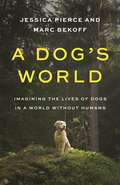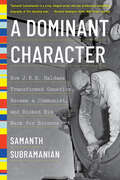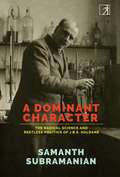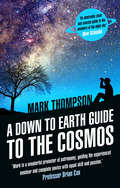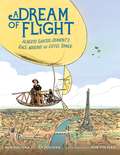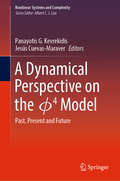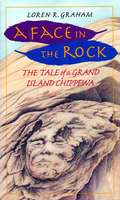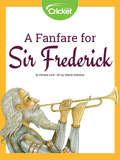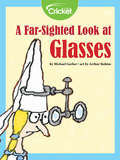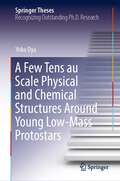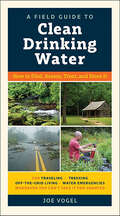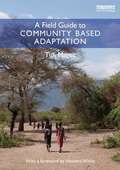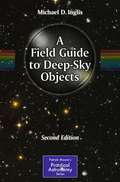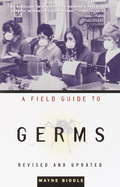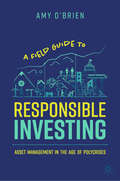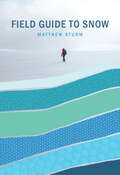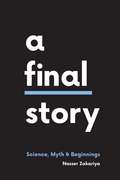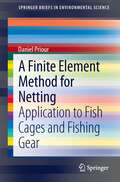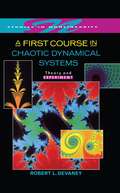- Table View
- List View
A Dog's Body
by Amy TaoDogs are amazing creatures with amazing bodies! Discover how fur protects their delicate skin, and which body parts gives them balance. Did you know dogs can wiggle their ears in many directions? Learn more facts about dogs and how their unique anatomy is different from other animals.
A Dog's World: Imagining the Lives of Dogs in a World without Humans
by Marc Bekoff Jessica PierceFrom two of the world’s leading authorities on dogs, an imaginative journey into a future of dogs without peopleWhat would happen to dogs if humans simply disappeared? Would dogs be able to survive on their own without us? A Dog’s World imagines a posthuman future for dogs, revealing how dogs would survive—and possibly even thrive—and explaining how this new and revolutionary perspective can guide how we interact with dogs now.Drawing on biology, ecology, and the latest findings on the lives and behavior of dogs and their wild relatives, Jessica Pierce and Marc Bekoff—two of today’s most innovative thinkers about dogs—explore who dogs might become without direct human intervention into breeding, arranged playdates at the dog park, regular feedings, and veterinary care. Pierce and Bekoff show how dogs are quick learners who are highly adaptable and opportunistic, and they offer compelling evidence that dogs already do survive on their own—and could do so in a world without us.Challenging the notion that dogs would be helpless without their human counterparts, A Dog’s World enables us to understand these independent and remarkably intelligent animals on their own terms.
A Dominant Character: The Radical Science And Restless Politics Of J. B. S. Haldane
by Samanth SubramanianA biography of J. B. S. Haldane, the brilliant and eccentric British scientist whose innovative predictions inspired Aldous Huxley’s Brave New World. J. B. S. Haldane’s life was rich and strange, never short on genius or drama—from his boyhood apprenticeship to his scientist father, who first instilled in him a devotion to the scientific method; to his time in the trenches during the First World War, where he wrote his first scientific paper; to his numerous experiments on himself, including inhaling dangerous levels of carbon dioxide and drinking hydrochloric acid; to his clandestine research for the British Admiralty during the Second World War. He is best remembered as a geneticist who revolutionized our understanding of evolution, but his peers hailed him as a polymath. One student called him “the last man who might know all there was to be known.” He foresaw in vitro fertilization, peak oil, and the hydrogen fuel cell, and his contributions ranged over physiology, genetics, evolutionary biology, mathematics, and biostatistics. He was also a staunch Communist, which led him to Spain during the Civil War and sparked suspicions that he was spying for the Soviets. He wrote copiously on science and politics in newspapers and magazines, and he gave speeches in town halls and on the radio—all of which made him, in his day, as famous in Britain as Einstein. It is the duty of scientists to think politically, Haldane believed, and he sought not simply to tell his readers what to think but to show them how to think. Beautifully written and richly detailed, Samanth Subramanian’s A Dominant Character recounts Haldane’s boisterous life and examines the questions he raised about the intersections of genetics and politics—questions that resonate even more urgently today.
A Dominant Character: The Science and Politics of J.B.S. Haldane
by Samanth SubramanianJ.B.S. Haldane, scientist extraordinaire—born in Britain yet spiritually bound to India—remains one of the most enigmatic geniuses of the modern era. Here is a man who saw action in two world wars, engaged in the most radical politics of his day, conducted groundbreaking scientific research, and wrote with flair and conviction—yet Haldane&’s universe remains shrouded in mystery. <P><P>Award-winning author Samanth Subramanian’s latest offering undoes this travesty. Besides shedding light on Haldane’s contributions to genetics and evolutionary biology—he was the first to calculate the rate at which mutations occur and accumulate in genes—the book illuminates Haldane&’s inner world—his towering intellect, his radical vision of society, his provocative philosophy, and his attempts a wrestling with the essential moral questions that scientific progress must raise. <P><P>Equally, the book dwells on Haldane’s years in India—his journey to the nation; his affiliation with the Indian Statistical Institute, Calcutta; his attachment to the Genetics and Biometry Laboratory in Bhubaneshwar (where he died). Dronamraju’s description of Haldane as ‘the last man who knew everything’ was, at its simplest, an acknowledgement of his command over multiple subjects. But it was also an astute observation that Haldane’s era was the last time when the realms of scientific knowledge were limited enough for a single person to apprehend in near-entirety. To know everything was to see the forces of the world unified and to conceive of life in its full complexity. A Dominant Character will give readers a taste of that heady sensation.
A Down to Earth Guide to the Cosmos
by Mark ThompsonTo the beginner, the star-filled night sky can seem mysterious and unfathomable. But with this book as a guide the awesome nature of the Cosmos is brought down to Earth. Over the course of twelve chapters Mark Thompson, one of the presenters on BBC One’s Stargazing Live and the resident astronomer on ITV’s The Alan Titchmarsh Show, will take you on a journey through space, tackling the key concepts of astronomy and unlocking the secrets of the sky. From the origins of our Universe to the ever evolving techniques used to explore deep space, A Down to Earth Guide to the Cosmos traces the journey of galactic discovery that has obsessed mankind for thousands of years.Accompanying the narrative, a series of monthly sky guides focus on the astronomical highlights visible at each given time of year, with handy charts to show you exactly what to look for and how to navigate around the sky at night. As fascinating as it is accessible, A Down to Earth Guide to the Cosmos is a must for anyone who gazes up and wishes they knew more about the final frontier...
A Dream of Flight: Alberto Santos-Dumont's Race Around the Eiffel Tower
by Rob Polivka Jef PolivkaDebut nonfiction duo Rob and Jef Polivka offer an illustrated madcap adventure in A Dream of Flight, a dynamic biography of Alberto Santos-Dumont, an inventor who risked everything to reach the skies. And sure enough, his successes and failures brought the world’s people closer together.Ready? Set. Fly! At the turn of the twentieth century, no aviation prize was more coveted in Europe than the Deutsch Prize. To win it, a pilot would have to fly a balloon from Paris’s Aero Club around the Eiffel Tower and back in thirty minutes or less. Who would be the first to succeed?Alberto Santos-Dumont thought he could. His latest design, Airship No. 6, was perfected from the countless lessons he learned during previous crashes. On the morning of October 19, 1901, Santos was making good time in the race when disaster struck—his motor had sputtered to a stop mid-air! Would Santos make it to the finish line in time—let alone survive?
A Dynamical Perspective on the ɸ4 Model: Past, Present and Future (Nonlinear Systems and Complexity #26)
by Jesús Cuevas-Maraver Panayotis G. KevrekidisThis book presents a careful selection of the most important developments of the \phi^4 model, offering a judicious summary of this model with a view to future prospects and the challenges ahead. Over the past four decades, the \phi^4 model has been the basis for a broad array of developments in the physics and mathematics of nonlinear waves. From kinks to breathers, from continuum media to discrete lattices, from collisions of solitary waves to spectral properties, and from deterministic to stochastic models of \phi^4 (and \phi^6, \phi^8, \phi^12 variants more recently), this dynamical model has served as an excellent test bed for formulating and testing the ideas of nonlinear science and solitary waves.
A Face in the Rock: The Tale Of A Grand Island Chippewa
by Loren R. Graham Abigail RorerEight miles long and four miles wide, Grand Island lies off the south shore of Lake Superior. It was once home to a sizable community of Chippewa Indians who lived in harmony with the land and with each other. Their tragic demise began early in the nineteenth century when their fellow tribesmen from the mainland goaded them into waging war against rival Sioux. The war party was decimated; only one young brave, Powers of the Air, lived to tell the story that celebrated the heroism of his band and formed the basis of the legend that survives today. Distinguished historian Loren R. Graham has spent more than forty years researching and reconstructing the poignant tale of Powers of the Air and his people. A Face in the Rock is an artful melding of human history and natural history; it is a fascinating narrative of the intimate relation between place and people. Powers of the Air lived to witness the desecration of Grand Island by the fur and logging industries, the Christianization of the tribe, and the near total loss of the Chippewa language, history, and culture. Graham charts the plight of the Chippewa as white culture steadily encroaches, forcing the native people off the island and dispersing their community on the mainland. The story ends with happier events of the past two decades, including the protection of Grand Island within the National Forest system, and the resurgence of Chippewa culture.
A Fanfare for Sir Frederick
by Susan Yoder AckermanAgnes is learning how to play the trumpet! Every time she tries to practice, though, an old knight bursts in because he thinks her trumpet sounds like a dragon. Through these interruptions, she learns the knight is responsible for stopping attacks on their kingdom. How can she help this bored hero?
A Far-Infrared Spectro-Spatial Space Interferometer: Instrument Simulator and Testbed Implementation (Springer Theses)
by Roser Juanola-ParramonThis thesis describes the physics and computational aspects of an end-to-end simulator to predict the performance of a Space-based Far Infrared Interferometer. The present thesis also includes, the science capabilities and instrumental state-of-the art. The latter is the ambitious next step which the Far-Infrared Astrophysical community needs to take to improve in anyway on the results of the most recent and current space telescopes in this wavelength region. This thesis outlines the requirements involved in such a mission and describes the most promising technique to capture most of the astrophysical information by combining spectroscopy to spatial interferometer. The simulation of such a system is extremely complex requiring multiple Fourier transforms each of which is subject to instrument non-idealities and appropriate optimization techniques. As a conclusion, the thesis provides an example of the basic performance achievable with such an instrument when targeting a young star formation region.
A Far-Sighted Look at Glasses
by Michael GerberHave you ever wondered where glasses came from? This comic takes a fun look at the invention of glasses starting with the Greeks and Romans. Then it looks at attempts by the Spanish, Chinese, French, and even inventor Ben Franklin to improve the design.
A Feeling for the Organism: The Life and Work of Barbara McClintock
by Evelyn F. Keller W. H. FreemanBiography of the scientist, written in 1983 before she was awarded the Nobel Prize.
A Few Tens au Scale Physical and Chemical Structures Around Young Low-Mass Protostars (Springer Theses)
by Yoko OyaThis book characterizes the kinematic and chemical structures of disk-forming regions around low-mass protostellar sources and their interplay based on Atacama Large Millimeter/submillimeter Array (ALMA) observations. It describes the chemical evolution of molecules formed in an interstellar gas using the ALMA observations of 5 Sun-like protostars at a spatial resolution of a few tens au scale, which unveils the physical mechanism of star and planetary formation. The book reviews the author’s successful works, focusing on two key findings: (i) A drastic change in the chemical composition of the gas around the centrifugal barrier of the infalling-rotating envelopes, and (ii) the chemical composition in the disk-forming regions, which varies from source to source depending on the chemical characteristics of the parent molecular cloud. These findings are based on the fine characterization of physical structures based on careful kinematic analyses. An additional attraction is the inclusion of the skillful reviews of ALMA observatory and its observation and physical models to describe the observed gas structure.
A Field Guide to Clean Drinking Water: How to Find, Assess, Treat, and Store It
by Joe VogelHow to find and prepare safe drinking water—anywhere, any time! Clean drinking water may be the last thing we think about day to day—but it’s the first thing we need in an emergency. Now, survival expert and biologist Joe Vogel explains how to find, treat, and store safe drinking water—even in the most extreme conditions. A Field Guide to Clean Drinking Water includes information about: ·The role of water in the body and how to calculate your water requirement ·Plants, geographical features, and more indicators that signal the presence of water ·How to collect dew and precipitation, and extract water from plants ·How to screen “raw water” for bacteria, pesticides, and other contaminants ·Every purifying method from boiling techniques to chemical disinfection ·And storage options that meet every need.Small enough to take anywhere—and broad enough to cover everything—this is a vital manual for backpackers, survivalists, and anyone who may need to know how to create their own drinking water.
A Field Guide to Climate Change: Understanding the Problems
by Adam BriggleThis book is a guide for understanding climate change. It takes an interdisciplinary approach because climate change is simultaneously a matter of science, engineering, economics, politics, culture, ethics, and more. A Field Guide to Climate Change thus follows the contours of climate change as it appears in the world—as a tangle of problems. Briggle presents climate literacy as a form of problem-posing by offering a set of tools for understanding how problems get framed, debated, and resolved. Through developing climate literacy, students gain the ability to think critically about how facts are constructed and mobilized in the pursuit of values. <P><P> Part One (Big Picture and Fundamentals) provides basic definitions and broad orientation by situating climate change within larger contexts like the Anthropocene, international climate diplomacy, sustainable development, and “green growth.” Part Two (Climate Sciences) offers tools for understanding climate science, its historical development, and its place in society by asking: who knows, what do we know, and how do we know it? Part Three (Politics, Ethics, and Policy) shows how to analyze debates about climate change policies from mitigation to rewilding.
A Field Guide to Community Based Adaptation
by Tim MageeThis book illustrates how including community members in project design and co-management leads to long-lasting, successful achievement of development and adaptation goals.
A Field Guide to Deep-Sky Objects (The Patrick Moore Practical Astronomy Series)
by Mike InglisThis star guide enables amateur astronomers to focus on a class of object, and using an observation list that begins with the easiest object, find and move progressively over a period of months to more difficult targets. Includes detailed descriptive summaries of each class of object. Amateur astronomers of all levels will find this book invaluable for its broad-ranging background material, its lists of fascinating objects, and for its power to improve practical observing skills while viewing many different types of deep-sky objects. This new edition of A Field Guide to Deep-sky Objects brings in a correction of out-of-date science along with two new chapters; Transient objects, and Naked-Eye Deep Sky Objects. This edition adds up-to-date information and on the objects mentioned above. This new edition of A Field Guide to Deep-sky Objects brings in a correction of out-of-date science along with two new chapters; Transient objects, and Naked-Eye Deep Sky Objects. This edition adds up-to-date information and on the objects mentioned above.
A Field Guide to Germs (Newly Revised and Updated): Revised and Updated
by Wayne BiddleFrom the ravages of the Ebola virus in Zaire to outbreaks of pneumonic plague in India and drug-resistant TB in New York City, contagious diseases are fighting back against once-unconquerable modern medicine. Public concern about infectious disease is on the rise as newspapers trumpet the arrivals of new germs and the reemergence of old ones. In A Field Guide to Germs, Pulitzer Prize-winning science writer Wayne Biddle brings readers face to face with nearly one hundred of the best-known (in terms of prevalence, power, historical importance, or even literary interest) of the myriad pathogens that live in and around the human population. Along with physical descriptions of the organisms and the afflictions they cause, the author provides folklore, philosophy, history, and such illustrations as nineteenth century drawings of plague-induced panic, microscopic photographs of HIV and Ebola, and wartime posters warning servicemen against syphilis and gonorrhea. From cholera to chlamydia, TB to HIV, bubonic plague to Lyme disease, rabies to Congo-Crimean encephalitis, anthrax to Zika fever, and back to good old rhinitis (the common cold), A Field Guide to Germs is both a handy reference work to better understand today's headlines and a fascinating look at the astonishing impact of micro-organisms on social and political history.
A Field Guide to Lies: Critical Thinking in the Information Age
by Daniel J. LevitinWinner of the Mavis Gallant Prize for Non-FictionWinner of the 2017 National Business Book AwardShortlisted for the 2016/2017 Donner PrizeFrom the bestselling author of The Organized Mind, the must-have book about how to analyze who and what to trust in the age of information overload. It's becoming harder to separate the wheat from the digital chaff. How do we distinguish misinformation, pseudo-facts, distortions and outright lies from reliable information? In A Field Guide to Lies, neuroscientist Daniel Levitin outlines the many pitfalls of the information age and provides the means to spot and avoid them. Levitin groups his field guide into two categories--statistical infomation and faulty arguments--ultimately showing how science is the bedrock of critical thinking. It is easy to lie with stats and graphs as few people "take the time to look under the hood and see how they work." And, just because there's a number on something, doesn't mean that the number was arrived at properly. Logic can help to evaluate whether or not a chain of reasoning is valid. And "infoliteracy" teaches us that not all sources of information are equal, and that biases can distort data. Faced with a world too eager to flood us with information, the best response is to be prepared. A Field Guide to Lies helps us avoid learning a lot of things that aren't true.
A Field Guide to Radiation
by Wayne BiddleA comprehensive and accessible guide to understanding how radiation affects our everyday lives Nuclear energy, X-rays, radon, cell phones . . . radiation is part of the way we live on a daily basis, and yet the sources and repercussions of our exposure to it remain mysterious. Now Pulitzer Prize–winning journalist Wayne Biddle offers a first-of-its-kind guide to understanding this fundamental aspect of the universe. From fallout to radiation poisoning, alpha particles to cosmic rays, Biddle illuminates the history, meaning, and health implications of one hundred scientific terms in succinct, witty essays. A Field Guide to Radiation is an essential, engaging handbook that offers wisdom and common sense for today's increasingly nuclear world. .
A Field Guide to Responsible Investing: Asset Management in the Age of Polycrises
by Amy O'BrienFor years, responsible investing has been a bewildering precinct in asset management. To many, the idea of aligning your values with your investment portfolio seemed naive. Slowly and steadily, responsible investing morphed from a movement into an industry on course to command $50 trillion in assets by 2025— a third of the capital at work in the markets. And yet responsible investing has remained as difficult to traverse as ever. It&’s drawn fire from critics who&’ve branded the approach &“woke capitalism&” whilst more &“responsible&” generations of investors are poised to marshal trillions of assets of their own into the business - we are at an inflection point. As a responsible investing practitioner for more than 25 years, author Amy O&’Brien has taken part in this revolution in asset management. With geopolitical conflicts, economic instability, and climate change fomenting unprecedented &“polycrises&”, she believes there is no more effective way to address the challenges of the 21st century than through responsible investing. Like most tectonic shifts in asset management, responsible investing has been complicated, hard to define, and hard to measure. But doing so is not only possible, it's also imperative. Over nine chapters, the book takes readers on a journey of the evolution of responsible investing, how it works today, why it&’s integral to investment considerations, and how we can finally get a grip on its efficacy. It&’s time to demystify and unpack this invaluable method for managing our assets, and our futures.
A Field Guide to Snow (Snowy Owl)
by Matthew SturmPeople love snow. They love to ski and sled on it, snowshoe through it, and watch it fall from the sky. They love the way it blankets a landscape, making it look tranquil and beautiful. Few people, however, know how snow works. What makes it possible for us to slip and slide over, whether that’s falling on sidewalks or skiing down a mountain? What makes it cling to branches and street signs? What qualities of snow lead to avalanches? In A Field Guide to Snow, veteran snow scientist Matthew Sturm answers those questions and more. Drawing on decades of study, he explains in clear and simple ways how and why snow works the way it does. The perfect companion a ski trip or a hike in the snowy woods, A Field Guide to Snow will give you a new appreciation for the science behind snow’s beauty.
A Final Story: Science, Myth, & Beginnings
by Nasser ZakariyaPopular science readers embrace epics—the sweeping stories that claim to tell the history of all the universe, from the cosmological to the biological to the social. And the appeal is understandable: in writing these works, authors such as E. O. Wilson or Steven Weinberg deliberately seek to move beyond particular disciplines, to create a compelling story weaving together natural historical events, scientific endeavor, human discovery, and contemporary existential concerns. In AFinal Story, Nasser Zakariya delves into the origins and ambitions of these scientific epics, from the nineteenth century to the present, to see what they reveal about the relationship between storytelling, integrated scientific knowledge, and historical method. While seeking to transcend the perspectives of their own eras, the authors of the epics and the debates surrounding them are embedded in political and social struggles of their own times, struggles to which the epics in turn respond. In attempts to narrate an approach to a final, true account, these synthesizing efforts shape and orient scientific developments old and new. By looking closely at the composition of science epics and the related genres developed along with them, we are able to view the historical narrative of science as a form of knowledge itself, one that discloses much about the development of our understanding of and relationship to science over time.
A Finite Element Method for Netting: Application to fish cages and fishing gear (SpringerBriefs in Environmental Science)
by Daniel PriourThis book fully describes a finite element method for netting. That describes the relation between forces and deformation of the netting. That takes into account forces due to the twine elasticity, the hydrodynamic forces, the catch effect, the mesh opening stiffness. This book is divided in 5 parts. The first section contains introduction on the finite element method, the second part is about equilibrium calculation, the third presents a triangular element for netting, the fourth and fifth are for cable and node element. The sixth presents few validation cases.
A First Course in Chaotic Dynamical Systems: Theory And Experiment
by Robert L. DevaneyA First Course in Chaotic Dynamical Systems: Theory and Experiment is the first book to introduce modern topics in dynamical systems at the undergraduate level. <P><P>Accessible to readers with only a background in calculus, the book integrates both theory and computer experiments into its coverage of contemporary ideas in dynamics. It is designed as a gradual introduction to the basic mathematical ideas behind such topics as chaos, fractals, Newton's method, symbolic dynamics, the Julia set, and the Mandelbrot set, and includes biographies of some of the leading researchers in the field of dynamical systems. Mathematical and computer experiments are integrated throughout the text to help illustrate the meaning of the theorems presented. Chaotic Dynamical Systems Software, Labs 1-6 is a supplementary laboratory software package, available separately, that allows a more intuitive understanding of the mathematics behind dynamical systems theory. Combined with A First Course in Chaotic Dynamical Systems, it leads to a rich understanding of this emerging field.

